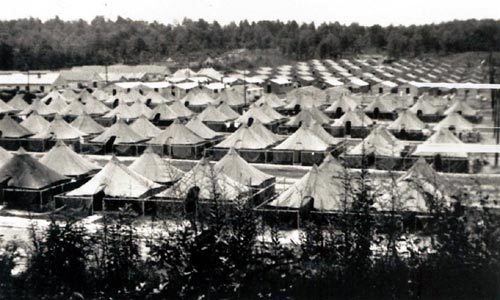Type Military training base Year built 1940 Controlled by United States of America | In use 1941 – ca. 1946 Phone +1 706-886-2457 | |
 | ||
Address 2351 Ayersville Rd, Toccoa, GA 30577, USA Similar Currahee Mountain, Currahee Military Museum, Toccoa Falls, Utah Beach, Kehlsteinhaus | ||
Exploring camp toccoa
Camp Toccoa (formerly Camp Toombs) was a United States Army paratrooper training camp during World War II five miles (eight kilometers) west of Toccoa, Georgia. It was first planned in 1938, constructed by the Georgia National Guard and the Works Projects Administration beginning 17 January 1940, and was dedicated 14 December 1940. The U.S. Army took over the site in 1942.
Contents
- Exploring camp toccoa
- Camp toccoa video
- World War II
- After World War II
- Units trained at Toccoa
- Name change
- References
Camp toccoa video
World War II
The U.S. Army took over a site with few buildings or permanent structures: personnel were originally housed in tents. More permanent barracks were built as the first soldiers started to arrive.
Initially, Camp Toccoa used the Toccoa municipal airport for jump training, but following a transport accident, it was abandoned for having too short a runway for safe C-39 and C-47 operations. All further jump training occurred at Fort Benning, Georgia.
Camp Toccoa also lacked a rifle range, so airborne trainees would march 30 miles (48 km) to Clemson Agricultural College, a military school in South Carolina, to practice on the college's shooting range.
The most prominent local landmark is Currahee Mountain. Paratroopers in training ran from the camp up the mountain and back, memorialized in the HBO series, Band of Brothers, with the shout "three miles up, three miles down." Members of the 506th Parachute Infantry Regiment still refer to themselves as "Currahees", derived from the Cherokee word gurahiyi, which means "stand alone, together". The crest is surmounted by a group of 6 fully deployedparachutes.
Rod Serling, creator of the Twilight Zone, started his military career here in 1943.
After World War II
The camp closed at the end of the war. In the late 1940s, it served as a Georgia State Prison site, housing primarily youth offenders, but several escapes forced the state to close the site, moving the operation to a new facility at Alto, Georgia. The twisting trail up Currahee is now named for Colonel Sink. The only remaining building from the camp is the mess hall, which sits on a corner of a Milliken & Company textile plant. The Patterson Pump Company occupies another portion of the grounds.
In 2012 an organization, Camp Toccoa at Currahee, a not-for profit foundation, was formed to celebrate the lives and contributions of the Airborne paratroopers who trained at Camp Toccoa at Currahee Mountain during World War II. A plan was set forth to restore the facilities at the camp site.
Units trained at Toccoa
Name change
The facility was initially named Camp Toombs General after Confederate Civil War General Robert Toombs. In 1942, Colonel Robert Sink, commander of the 506th Parachute Infantry Regiment, one of the first units to train there, thought that it would prompt superstitions to have young men arrive at Toccoa, travel Route 13 past the Toccoa Casket Company to learn to jump at Camp "Tombs", so he persuaded the Department of the Army to change the name to Camp Toccoa.
